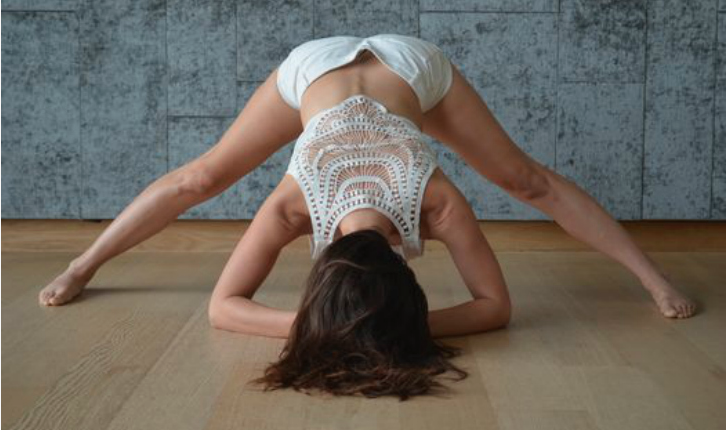10 Yoga Poses That Will Improve Your Sex
10 Yoga Poses That Will Improve Your Sex. Indian scientists recommend.
How Yoga Helps Improve Sex Quality
Yoga classes develop strength, flexibility and a sense of balance, but this is not a big advantage for those who do not like to curl up into a ram’s horn during sex.
As a rule, sexual intercourse does not require special strength and dexterity – perhaps only endurance, but you cannot pump it up with yoga. And yet, the ancient Indian practice can improve the quality of sex through its impact on the psyche.
Everyday stress reduces the quality of sex. Burnout at work, high blood pressure and alcohol consumption increase erectile dysfunction in men and reduce overall satisfaction with sex. In women, work stress reduces lubrication and negatively affects the ability to achieve orgasm.
Yoga helps reduce stress . An analysis of 42 scientific studies showed that regular yoga practice reduces levels of the “stress hormone” cortisol immediately upon waking and in the evening, has a beneficial effect on blood pressure and heart rate, heart rate variability, and even cholesterol levels.

Yoga asanas shift the balance of the autonomic nervous system from the sympathetic, fight-or-flight response, to the parasympathetic, calm, response. And this affects the ability to become aroused and enjoy sex.
The relationship between sexual satisfaction and yoga has been little studied, but there is some evidence from Indian studies. In one study , 12 weeks of doing yoga poses for an hour a day significantly improved all measures of sexual performance in women, including desire, arousal, lubrication, orgasm, and satisfaction.
The ancient practice also helps men. In another experiment , scientists tested whether yoga could defeat premature ejaculation.
The experiment involved 68 people, divided into two groups. About half of the men took fluoxetine, the rest did yoga for an hour a day. After eight weeks, all the men in the yoga group showed significant improvements.
Scientists have suggested that the positive effects of yoga are due to a shift in the autonomic nervous system towards the parasympathetic division, which provides greater control over ejaculation.
What positions to do to improve the quality of sex
We will present several poses that were used in both studies mentioned above (except for the fish pose, which was not used in the experiment on men).
1. Diamond Pose (Vajrasana)
Sit on the floor, straighten your back and stretch your legs forward. Bend your knees one by one, place your shins on the floor and connect your big toes. Spread your heels apart and place your pelvis between them.
Place your palms on your knees, straighten your back, straighten your shoulders, stretch your head toward the ceiling. Make sure your back remains straight, without excessive arching in the lower back. Stay in this pose for 1–5 minutes. Watch your breathing – let your focus be only on inhaling and exhaling.
If you have knee problems or find this pose uncomfortable, place a rolled blanket or yoga block under your pelvis.
2. Yoga mudra – yoga for sexually strong for men
There are several variations of this pose: with legs crossed in the Turkish style or folded in the lotus position – full or half.
Try starting with half lotus position.
Sit on the floor and stretch your legs out in front of you. Bend your right knee, take your foot with your hands and place the back of it on your left thigh as close to your groin as possible, so that your heel is right next to your pelvic bone. Place your left foot under your right thigh.
Make sure your body weight is evenly distributed across both sitting bones and your back remains straight from your tailbone to your skull.
If you are comfortable in this pose, try the full lotus pose. Repeat all the steps from the beginning, but place the back of your left foot not under your right thigh, but on it.
If you are having trouble with the lotus position, simply cross your legs in front of you like a Turkish woman and move your feet slightly forward so that your shins are roughly parallel to each other.
Then put your hands behind your back and grasp your left wrist with your right hand. Straighten your back, relax your shoulders.
Inhale, lengthening your spine, and as you exhale, bend your torso forward until your forehead touches the floor. If you can’t reach the floor with your head, place a folded blanket or yoga block under your forehead.
Hold the pose for 30-60 seconds, rise up and repeat two more times.
3. Cobra Pose (Bhujangasana)
Lie on the floor on your stomach, put your legs together and point your toes so that the backs of your feet are on the mat. Bend your elbows and place your palms on the floor on either side of your chest. Squeeze your buttocks, pressing your pubic bone to the floor.
Lift your chest off the floor, arch your back, straighten your shoulders and open your chest, look at the ceiling. If you don’t have enough flexibility in your upper back, place your palms under your shoulders or even a little further in the starting position. This will allow you to arch more.
Hold the pose for 30 seconds, lower yourself back to the mat, rest, and repeat two more times.
4. Bow Pose (Dhanurasana)
Lie on your stomach, stretch your arms along your body. Bend your knees, lift your shins and clasp your ankles with your hands.
Maintaining the grip, smoothly lift your chest, upper abdomen and hips off the floor, looking up. Balance on your lower abdomen, trying to lift your arms and legs higher.
Hold the pose for 20-30 seconds, lower to the floor, rest and repeat two more times.
5. Fish Pose (Matsyasana)
You should not do this pose if you have problems with your cervical spine.
Lie on your back with your legs together and straight. Bend your elbows and place your forearms on the floor on either side of your body close to your pelvis.
With your forearms on the floor, pull your chest toward the ceiling, arch your back, throw your head back, and place the crown on the mat. Make sure that most of the weight is on your elbows. If you feel tension in your neck , press a little more on your forearms to shift the load onto them.
Hold the pose for 30 seconds, then press your elbows into the floor, release your neck and return to the starting position. Rest and repeat two more times.
6. Plow Pose (Halasana) – yoga poses for male stamina
Lie on your back, put your legs together, put your hands on the sides of your body. Press your hands on the floor, bend your knees and lift your legs and pelvis off the floor.
Place your legs behind your head and straighten your knees, touching the floor with your toes. Stay in this pose for 30 seconds, do not hold your breath. When the time is up, return to the starting position, rest a little and repeat two more times.
7. Supported Shoulderstand (Sarvangasana)
Lie on your back, stretch your arms along your body, bend your knees and place your feet closer to your pelvis. As you exhale, lift your pelvis off the floor and lift it up, positioning your body vertically. Press your chin to your chest and make sure that your body weight is on your shoulders, not your neck.
Bend your arms at the elbows, move them closer to each other and place your palms on your lower back, supporting your body with your hands. Straighten your legs at the knees, tighten your buttocks and stretch your body into one straight line from your shoulder blades to your feet.
Hold the pose for 15-30 seconds, then bend your knees and gently roll your back and then your pelvis to the floor. If you feel pressure on your neck, place a few rolled-up blankets under your shoulders so that your body rests on them and your head rests on the floor. This will take the pressure off your cervical spine and prevent you from getting a headache after the pose.
8. Half Matsyendra Pose (Ardha Matsyendrasana)
Sit on the floor with your legs stretched out in front of you. Bend your right knee and place your foot on the outside of your left thigh. Then bend your left knee and place it on the floor so that your left heel is next to your pelvis.
Place your right palm on the floor behind your back. Raise your left arm up, then rest your left elbow on the outside of your right knee and straighten your arm, pressing the back of it to your shin. Place your palm on your foot.
Twist your torso so that your shoulders are facing the wall to your right. Straighten your chest, lower your shoulders, and look toward your right hand. Hold the pose for 30 seconds, breathing deeply and evenly. Return to the starting position and repeat on the other side. Do the pose three times on each side.
9. Back Stretch Pose (Paschimottanasana)
Sit on the floor, put your legs together and stretch them out in front of you. Straighten your back and square your shoulders. Inhale and raise your straight arms up above your head so that they are level with your ears.
As you exhale, tuck your chin forward and, trying to keep your back straight, bend forward toward your legs. Grab your big toes, lower your elbows to the floor on either side of your legs, and lie down with your stomach on your legs.
If you have enough flexibility , you can put your hands behind your soles and interlock your fingers. If you don’t have enough flexibility, bend your knees slightly and try to lengthen your back with each inhale, and lower your stomach to your legs with each exhale. You can also place a rolled-up blanket under your pelvis to make the asana easier.
Hold the pose for 30-60 seconds, gently deepening the stretch, then rise to the starting position, rest briefly, and repeat two more times.
10. Corpse Pose (Shavasana)
This is a pose of complete relaxation that all yoga classes end with. Lie on the floor on your back, spread your hips slightly, and stretch your arms out to the sides of your body. Close your eyes and relax completely.
If you are uncomfortable lying in this position, try placing a folded blanket under your head. The main thing is that your neck is in a natural position and does not protrude forward.
To relieve lower back discomfort, you can place a rolled blanket under your hips near your buttocks. This will tilt your pelvis, press your lower back to the floor, and keep you in a comfortable position without excessive arching.
Spend 5-10 minutes in this pose, trying not to get caught up in your thoughts, but to concentrate on your breathing and the sensations of your body.
How often to exercise
Exercise every day. You can do it in the morning , right after waking up. Such exercises will help to stretch and loosen up the muscles that are stiff after sleep, and also help the brain to react more calmly to everyday stresses.
If you don’t have time in the morning, try exercising in the evening after work. This will help you calm down and relieve tension from your body and mind. In addition, due to the higher muscle temperature, your body will be more flexible and obedient than during your morning workout.
Try not to skip your workouts: studies have shown positive effects after daily practice for 8-12 weeks, so it makes sense to become a real yoga fanatic.
But don’t be upset if you have to skip workouts. After all, the main goal is to relieve stress.

